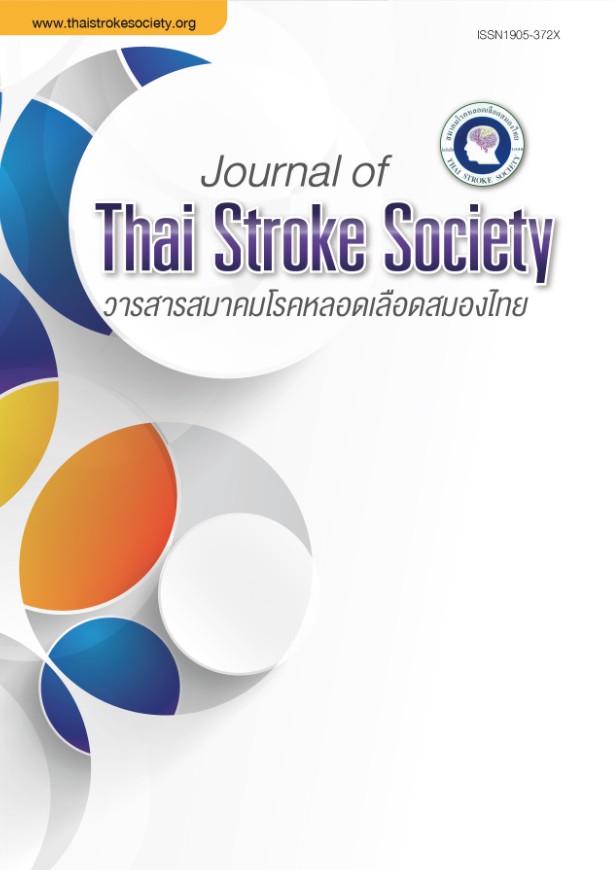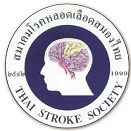TIA- Transient ischemic attack:
Keywords:
TIA, transient ischemic attack, stroke risk stratification, Atrial fibrillation, atherosclerosis, stroke preventionAbstract
A transient ischemic attack (TIA) is a stroke-warning event and represents a neurological emergency. Patients presenting with a high-risk TIA or minor stroke should be evaluated promptly, ideally within 24 hours. Accurate diagnosis of a true TIA and differentiating it from its mimics is always importance. Acute TIA carries higher risk than events occurring for several weeks. The risk predicting score, such as ABCD2 score, has been used for clinical risk stratification. Brain imaging, usually with a non-contrast CT scan, is indicated to exclude other pathology such as tumor and hemorrhage. However, the test of choice for TIA patients is a MRI scan. TIA is not an etiologic diagnosis; there are many possible causes. Patients with symptomatic large artery atherosclerosis have a higher risk of early stroke recurrence compared to those of other common causes. Carotid endarterectomy for significant extra-cranial carotid stenosis is most effective when performed within the first two weeks after ischemic event and its benefit declines with time. Atrial fibrillation (AF) is the most common cardiac cause of stroke and anticoagulant is highly beneficial for secondary stroke prevention. Antiplatelet therapy is the best options for non-cardioembolic TIA. Nevertheless, All patients benefit from stroke risk factors modification, particularly BP control.
References
Albers GW, Caplan LR, Easton JD, Fayad PB, Mohr JP, Saver JL, et al. Transient ischemic attack--proposal for a new definition. N Engl J Med. 2002;347(21):1713-6.
Easton JD, Saver JL, Albers GW, Alberts MJ, Chaturvedi S, Feldmann E, et al. Definition and evaluation of transient ischemic attack: a scientific statement for healthcare professionals from the American Heart Association/American Stroke Association Stroke Council; Council on Cardiovascular Surgery and Anesthesia; Council on Cardiovascular Radiology and Intervention; Council on Cardiovascular Nursing; and the Interdisciplinary Council on Peripheral Vascular Disease. The American Academy of Neurology affirms the value of this statement as an educational tool for neurologists. Stroke. 2009;40(6):2276-93.
Hand PJ, Kwan J, Lindley RI, Dennis MS, Wardlaw JM. Distinguishing between stroke and mimic at the bedside: the brain attack study. Stroke. 2006;37(3):769-75.
Fallon C, Noone I, Ryan J, O’Shea D, O’Laoide R, Crowe M. Assessment and management of transient ischaemic attack--the role of the TIA clinic. Ir J Med
Sci. 2006;175(3):24-7.
Coull AJ, Rothwell PM. Underestimation of the early risk of recurrent stroke: evidence of the need for a standard definition. Stroke. 2004;35(8):1925-9.
Rothwell PM, Buchan A, Johnston SC. Recent advances in management of transient ischaemic attacks and minor ischaemic strokes. Lancet Neurol.
2006;5(4):323-31.
Coull AJ, Lovett JK, Rothwell PM, Study OV. Population based study of early risk of stroke after transient ischaemic attack or minor stroke: implications for public education and organisation of services. BMJ. 2004;328(7435):326.
Johnston SC, Rothwell PM, Nguyen-Huynh MN, Giles MF, Elkins JS, Bernstein AL, et al. Validation and refinement of scores to predict very early stroke
risk after transient ischaemic attack. Lancet. 2007;369(9558):283-92.
Chandratheva A, Mehta Z, Geraghty OC, Marquardt L, Rothwell PM, Study OV. Population-based study of risk and predictors of stroke in the first few hours
after a TIA. Neurology. 2009;72(22):1941-7.
Olivot JM, Wolford C, Castle J, Mlynash M, Schwartz NE, Lansberg MG, et al. Two aces: transient ischemic attack work-up as outpatient assessment of clinical
evaluation and safety. Stroke. 2011;42(7):1839-43.
Dai Q, Sun W, Xiong Y, Hankey GJ, Xiao L, Zhu W, et al. From clinical to tissue-based dual TIA: Validation and refinement of ABCD3-I score. Neurology. 2015;84(14):1426-32.
Ay H, Koroshetz WJ, Benner T, Vangel MG, Wu O, Schwamm LH, et al. Transient ischemic attack with infarction: a unique syndrome? Ann Neurol.
2005;57(5):679-86.
Giles MF, Albers GW, Amarenco P, Arsava EM, Asimos AW, Ay H, et al. Early stroke risk and ABCD2 score performance in tissue- vs time-defined TIA: a
multicenter study. Neurology. 2011;77(13):1222-8.
Sposato LA, Cipriano LE, Saposnik G, Ruíz Vargas E, Riccio PM, Hachinski V. Diagnosis of atrial fibrillation after stroke and transient ischaemic attack:
a systematic review and meta-analysis. Lancet Neurol. 2015;14(4):377-87.
Grotta JC. Clinical practice. Carotid stenosis. N Engl J Med. 2013;369(12):1143-50.
Dharmasaroja PA, Intharakham K. Risk factors for carotid stenosis in Thai patients with ischemic stroke/TIA. Angiology. 2010;61(8):789-92.
Rothwell PM, Eliasziw M, Gutnikov SA, Warlow CP, Barnett HJ, Collaboration CET. Endarterectomy for symptomatic carotid stenosis in relation to clinical
subgroups and timing of surgery. Lancet. 2004;363(9413):915-24.
Chimowitz MI, Lynn MJ, Derdeyn CP, Turan TN, Fiorella D, Lane BF, et al. Stenting versus aggressive medical therapy for intracranial arterial stenosis. N
Engl J Med. 2011;365(11):993-1003.
Camm AJ, Kirchhof P, Lip GY, Schotten U, Savelieva I, Ernst S, et al. Guidelines for the management of atrial fibrillation: the Task Force for the Management of Atrial Fibrillation of the European Society of Cardiology (ESC). Eur Heart J. 2010;31(19):2369-429.
Lip GY, Frison L, Halperin JL, Lane DA. Identifying patients at high risk for stroke despite anticoagulation: a comparison of contemporary stroke risk stratification
schemes in an anticoagulated atrial fibrillation cohort. Stroke. 2010;41(12):2731-8.
Lane DA, Lip GY. Use of the CHA(2)DS(2)-VASc and HAS-BLED scores to aid decision making for thromboprophylaxis in nonvalvular atrial fibrillation.
Circulation. 2012;126(7):860-5.
Miller CS, Grandi SM, Shimony A, Filion KB, Eisenberg MJ. Meta-analysis of efficacy and safety of new oral anticoagulants (dabigatran, rivaroxaban,
apixaban) versus warfarin in patients with atrial fibrillation. Am J Cardiol. 2012;110(3):453-60.
Collaborative overview of randomised trials of antiplatelet therapy--I: Prevention of death, myocardial infarction, and stroke by prolonged antiplatelet
therapy in various categories of patients. Antiplatelet Trialists’ Collaboration. BMJ. 1994;308(6921):81-106.
Halkes PH, van Gijn J, Kappelle LJ, Koudstaal PJ, Algra A, Group ES. Aspirin plus dipyridamole versus aspirin alone after cerebral ischaemia of arterial
origin (ESPRIT): randomised controlled trial. Lancet. 2006;367(9523):1665-73.
Sacco RL, Diener HC, Yusuf S, Cotton D, Ounpuu S, Lawton WA, et al. Aspirin and extended-release dipyridamole versus clopidogrel for recurrent stroke.
N Engl J Med. 2008;359(12):1238-51.
Committee CS. A randomised, blinded, trial of clopidogrel versus aspirin in patients at risk of ischaemic events (CAPRIE). CAPRIE Steering Committee. Lancet. 1996;348(9038):1329-39.
Shinohara Y, Katayama Y, Uchiyama S, Yamaguchi T, Handa S, Matsuoka K, et al. Cilostazol for prevention of secondary stroke (CSPS 2): an aspirin-controlled, double-blind, randomised noninferiority trial. Lancet Neurol. 2010;9(10):959-68.
Diener HC, Bogousslavsky J, Brass LM, Cimminiello C, Csiba L, Kaste M, et al. Aspirin and clopidogrel compared with clopidogrel alone after recent ischaemic
stroke or transient ischaemic attack in high-risk patients (MATCH): randomised, double-blind, placebo-controlled trial. Lancet. 2004;364(9431):331-7.
Benavente OR, Hart RG, McClure LA, Szychowski JM, Coffey CS, Pearce LA, et al. Effects of clopidogrel added to aspirin in patients with recent lacunar stroke.
N Engl J Med. 2012;367(9):817-25.
Rothwell PM, Giles MF, Chandratheva A, Marquardt L, Geraghty O, Redgrave JN, et al. Effect of urgent treatment of transient ischaemic attack and minor
stroke on early recurrent stroke (EXPRESS study): a prospective population-based sequential comparison. Lancet. 2007;370(9596):1432-42.
Markus HS, Droste DW, Kaps M, Larrue V, Lees KR, Siebler M, et al. Dual antiplatelet therapy with clopidogrel and aspirin in symptomatic carotid stenosis evaluated using doppler embolic signal detection: the Clopidogrel and Aspirin for Reduction of Emboli in Symptomatic Carotid Stenosis (CARESS) trial. Circulation. 2005;111(17):2233-40.
Wong KS, Chen C, Fu J, Chang HM, Suwanwela NC, Huang YN, et al. Clopidogrel plus aspirin versus aspirin alone for reducing embolisation in patients with
acute symptomatic cerebral or carotid artery stenosis (CLAIR study): a randomised, open-label, blindedendpoint trial. Lancet Neurol. 2010;9(5):489-97.
Kennedy J, Hill MD, Ryckborst KJ, Eliasziw M, Demchuk AM, Buchan AM, et al. Fast assessment of stroke and transient ischaemic attack to prevent early
recurrence (FASTER): a randomised controlled pilot trial. Lancet Neurol. 2007;6(11):961-9.
Wang Y, Zhao X, Liu L, Wang D, Wang C, Li H, et al. Clopidogrel with aspirin in acute minor stroke or transient ischemic attack. N Engl J Med. 2013;369(1):11-9.
Lee M, Saver JL, Hong KS, Rao NM, Wu YL, Ovbiagele B. Risk-benefit profile of long-term dualversus single-antiplatelet therapy among patients with ischemic stroke: a systematic review and metaanalysis. Ann Intern Med. 2013;159(7):463-70.
Boan AD, Lackland DT, Ovbiagele B. Lowering of blood pressure for recurrent stroke prevention. Stroke. 2014;45(8):2506-13.
Turnbull F, Collaboration BPLTT. Effects of different blood-pressure-lowering regimens on major cardiovascular events: results of prospectivelydesigned
overviews of randomised trials. Lancet. 2003;362(9395):1527-35.
Amarenco P, Bogousslavsky J, Callahan A, Goldstein LB, Hennerici M, Rudolph AE, et al. High-dose atorvastatin after stroke or transient ischemic attack.
N Engl J Med. 2006;355(6):549-59.
Jarcho JA, Keaney JF. Proof That Lower Is Better--LDL Cholesterol and IMPROVE-IT. N Engl J Med. 2015;372(25):2448-50.
Wang X, Dong Y, Qi X, Huang C, Hou L. Cholesterol levels and risk of hemorrhagic stroke: a systematic review and meta-analysis. Stroke. 2013;44(7):1833-9.
Downloads
Published
How to Cite
Issue
Section
License
ข้อความภายในบทความที่ตีพิมพ์ในวารสารสมาคมโรคหลอดเลือดสมองไทยเล่มนี้ ตลอดจนความรับผิดชอบด้านเนื้อหาและการตรวจร่างบทความเป็นของผู้นิพนธ์ ไม่เกี่ยวข้องกับกองบรรณาธิการแต่อย่างใด การนำเนื้อหา ข้อความหรือข้อคิดเห็นของบทความไปเผยแพร่ ต้องได้รับอนุญาตจากกองบรรณาธิการอย่างเป็นลายลักษณ์อักษร ผลงานที่ได้รับการตีพิมพ์ในวารสารเล่มนี้ถือเป็นลิขสิทธิ์ของวารสาร





